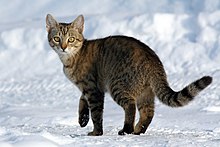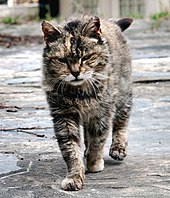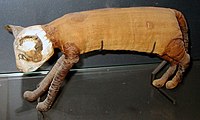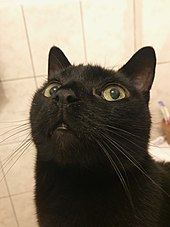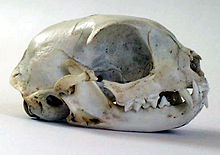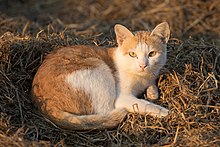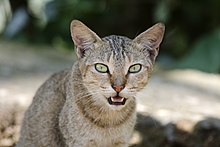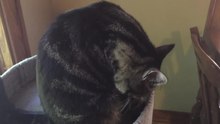Size

Diagram of the general
anatomy of a male domestic cat
The domestic cat has a smaller
skull and shorter bones than the
European wildcat.
[51] It averages about 46 cm (18 in) in head-to-body length and 23–25 cm (9.1–9.8 in) in height, with about 30 cm (12 in) long tails. Males are larger than females.
[52] Adult domestic cats typically weigh between 4 and 5 kg (8.8 and 11.0 lb).
[36]
Skeleton
Cats have seven
cervical vertebrae (as do most
mammals); 13
thoracic vertebrae (humans have 12); seven
lumbar vertebrae (humans have five); three
sacral vertebrae (as do most mammals, but humans have five); and a variable number of
caudal vertebrae in the tail (humans have only vestigial caudal vertebrae, fused into an internal
coccyx).
[53]:11 The extra lumbar and thoracic vertebrae account for the cat's spinal mobility and flexibility. Attached to the spine are 13 ribs, the shoulder, and the
pelvis.
[53] :16 Unlike human arms, cat forelimbs are attached to the shoulder by free-floating
clavicle bones which allow them to pass their body through any space into which they can fit their head.
[54]
Skull
The cat skull is unusual among mammals in having very large
eye sockets and a powerful specialized jaw.
[55]:35 Within the jaw, cats have teeth adapted for killing prey and tearing meat. When it overpowers its prey, a cat delivers a lethal neck bite with its two long
canine teeth, inserting them between two of the prey's vertebrae and severing its
spinal cord, causing irreversible
paralysis and death.
[56] Compared to other felines, domestic cats have narrowly spaced canine teeth relative to the size of their jaw, which is an adaptation to their preferred prey of small rodents, which have small vertebrae.
[56] The
premolar and first
molar together compose the
carnassial pair on each side of the mouth, which efficiently shears meat into small pieces, like a pair of scissors. These are vital in feeding, since cats' small
molars cannot chew food effectively, and cats are largely incapable of mastication.
[55]:37 Although cats tend to have better teeth than most humans, with decay generally less likely because of a thicker protective layer of enamel, a less damaging saliva, less retention of food particles between teeth, and a diet mostly devoid of sugar, they are nonetheless subject to occasional tooth loss and infection.
[57]
Ambulation
The cat is
digitigrade. It walks on the toes, with the bones of the feet making up the lower part of the visible leg.
[58] Unlike most mammals, it uses a "pacing"
gait and moves both legs on one side of the body before the legs on the other side. It registers directly by placing each hind paw close to the track of the corresponding fore paw, minimizing noise and visible tracks. This also provides sure footing for hind paws when navigating rough terrain. As it speeds up walking to trotting, its gait changes to a "diagonal" gait: the diagonally opposite hind and fore legs move simultaneously.
[59]
Claws
Cats have protractable and retractable
claws.
[60] In their normal, relaxed position, the claws are sheathed with the skin and
fur around the
paw's toe pads. This keeps the claws sharp by preventing wear from contact with the ground and allows the silent stalking of prey. The claws on the fore feet are typically sharper than those on the hind feet.
[61] Cats can voluntarily extend their claws on one or more paws. They may extend their claws in hunting or self-defense, climbing,
kneading, or for extra traction on soft surfaces. Most cats have five claws on their front paws, and four on their rear paws. The
dewclaw is
proximal to the other claws. More proximally is a protrusion which appears to be a sixth "finger". This special feature of the front paws, on the inside of the wrists has no function in normal walking, but is thought to be an antiskidding device used while jumping. Some breeds of cats are prone to
polydactyly.
[62] Polydactyly is a
mutation of the forelimb. Polydactylous cats occur along North America' northeast coast and in Great Britain.
[63]
Senses
Vision
Cats have excellent
night vision and can see at only one-sixth the light level required for human vision.
[55]:43 This is partly the result of cat eyes having a
tapetum lucidum, which reflects any light that passes through the
retina back into the eye, thereby increasing the eye's sensitivity to dim light.
[64] Large pupils are an adaptation to dim light. The domestic cat has
slit pupils, which allow it to focus bright light without
chromatic aberration.
[65] At low light, a cat's pupils expand to cover most of the exposed surface of its eyes.
[66] However, the domestic cat has rather poor
color vision and only two types of
cone cells, optimized for sensitivity to blue and yellowish green; its ability to distinguish between red and green is limited.
[67] A response to middle wavelengths from a system other than the
rod cells might be due to a third type of cone. However, this appears to be an adaptation to low light levels rather than representing true
trichromatic vision.
[68]
Hearing
The domestic cat's
hearing is most acute in the range of 500 Hz to 32 kHz.
[69] It can detect an extremely broad range of frequencies ranging from 55 Hz to 79,000 Hz. It can hear a range of 10.5
octaves, while humans and dogs can hear ranges of about 9 octaves.
[70][71] Its hearing sensitivity is enhanced by its large movable outer ears, the
pinnae, which amplify sounds and help detect the location of a noise. It can detect
ultrasound, which enables it to detect ultrasonic calls made by
rodent prey.
[72][73]
Smell
Cats have an acute sense of smell, due in part to their well-developed
olfactory bulb and a large surface of
olfactory mucosa, about 5.8 cm
2 (0.90 in
2) in area, which is about twice that of humans.
[74] Cats and many other animals have a
Jacobson's organ in their mouths that is used in the behavioral process of
flehmening. It allows them to sense certain aromas in a way that humans cannot. Cats are sensitive to
pheromones such as
3-mercapto-3-methylbutan-1-ol,
[75] which they use to communicate through
urine spraying and marking with
scent glands.
[76] Many cats also respond strongly to plants that contain
nepetalactone, especially
catnip, as they can detect that substance at less than one part per billion.
[77] About 70–80% of cats are affected by nepetalactone.
[78] This response is also produced by other plants, such as silver vine (
Actinidia polygama) and the herb
valerian; it may be caused by the smell of these plants mimicking a pheromone and stimulating cats' social or sexual behaviors.
[79]
Taste
Cats have relatively few
taste buds compared to humans (470 or so versus more than 9,000 on the human tongue).
[80] Domestic and wild cats share a gene mutation that keeps their sweet taste buds from binding to sugary molecules, leaving them with no ability to taste
sweetness.
[81] Their taste buds instead respond to
acids,
amino acids like
protein, and
bitter tastes.
[82] Cats also have a distinct temperature preference for their food, preferring food with a temperature around 38 °C (100 °F) which is similar to that of a fresh kill and routinely rejecting food presented cold or refrigerated (which would signal to the cat that the "prey" item is long dead and therefore possibly toxic or decomposing).
[80]

The whiskers of a cat are highly sensitive to touch.
Whiskers
To aid with navigation and sensation, cats have dozens of movable
whiskers (vibrissae) over their body, especially their faces. These provide information on the width of gaps and on the location of objects in the dark, both by touching objects directly and by sensing air currents; they also trigger protective
blink reflexes to protect the eyes from damage.
[55]:47
Balance
Comparison of cat righting reflexes in
gravity vis-à-vis zero gravity
Most breeds of cat have a noted fondness for sitting in high places, or perching. A higher place may serve as a concealed site from which to hunt; domestic cats strike prey by pouncing from a perch such as a tree branch. Another possible explanation is that height gives the cat a better observation point, allowing it to survey its territory. A cat falling from heights of up to 3 meters can right itself and land on its paws.
[83] During a fall from a high place, a cat reflexively twists its body and rights itself to land on its feet using its acute
sense of balance and flexibility. This reflex is known as the
cat righting reflex.
[84] An individual cat always rights itself in the same way during a fall, provided it has sufficient time to do so. The height required for this to occur is around 90 cm (3.0 ft).
[85] Cats without a tail also have this reflex.
[86] Several explanations have been proposed for this phenomenon since the late 19th century:
Behavior
Outdoor cats are active both day and night, although they tend to be slightly more active at night.
[90] Domestic cats spend the majority of their time in the vicinity of their homes, but can range many hundreds of meters from this central point. They establish
territories that vary considerably in size, in one study ranging from 7 to 28 hectares (17–69 acres).
[91] The timing of cats' activity is quite flexible and varied, which means house cats may be more
active in the morning and evening, as a response to greater human activity at these times.
[92]
Cats conserve energy by sleeping more than most animals, especially as they grow older. The daily duration of sleep varies, usually between 12 and 16 hours, with 13 and 14 being the average. Some cats can sleep as much as 20 hours. The term "
cat nap" for a short rest refers to the cat's tendency to fall asleep (lightly) for a brief period. While asleep, cats experience short periods of
rapid eye movement sleep often accompanied by muscle twitches, which suggests they are
dreaming.
[93]
Sociability
The social behavior of the domestic cat ranges from widely dispersed individuals to
feral cat colonies that gather around a food source, based on groups of co-operating females.
[94][95] Within such groups, one cat is usually dominant over the others.
[96] Each cat in a colony holds a distinct territory, with sexually active males having the largest territories, which are about 10 times larger than those of female cats and may overlap with several females' territories. These territories are marked by
urine spraying, by rubbing objects at head height with secretions from facial glands, and by defecation.
[76] Between these territories are neutral areas where cats watch and greet one another without territorial conflicts. Outside these neutral areas, territory holders usually chase away stranger cats, at first by staring, hissing, and
growling and, if that does not work, by short but noisy and violent attacks. Despite some cats cohabiting in colonies, they do not have a social survival strategy, or a
pack mentality and always hunt alone.
[97]
However, some pet cats are poorly socialized. In particular, older cats show aggressiveness towards newly arrived kittens, which include biting and scratching; this type of behavior is known as feline asocial aggression.
[98]
Life in proximity to humans and other domestic animals has led to a symbiotic social adaptation in cats, and cats may express great affection toward humans or other animals.
Ethologically, the human keeper of a cat functions as a sort of surrogate for the cat's mother.
[99] Adult cats live their lives in a kind of extended kittenhood, a form of behavioral
neoteny. Their high-pitched sounds may mimic the cries of a hungry human infant, making them particularly difficult for humans to ignore.
[100]
Domestic cats'
scent rubbing behavior towards humans or other cats is thought to be a feline means for social bonding.
[101]
Communication
Domestic cats use many
vocalizations for communication, including
purring,
trilling, hissing,
growling/
snarling,
grunting, and several different forms of
meowing.
[7] Their
body language, including position of ears and tail, relaxation of the whole body, and kneading of the paws, are all indicators of mood. The tail and ears are particularly important social signal mechanisms in cats. A raised tail indicates a friendly greeting, and flattened ears indicates hostility. Tail-raising also indicates the cat's position in the group's
social hierarchy, with dominant individuals raising their tails less often than subordinate ones.
[102] By contrast, feral cats are generally silent.
[103]:208 Nose-to-nose touching is also a common greeting and may be followed by
social grooming, which is solicited by one of the cats raising and tilting its head.
[95]
Purring may have developed as an evolutionary advantage as a signalling mechanism of reassurance between mother cats and
nursing kittens. Post-nursing cats often purr as a sign of contentment: when being petted, becoming relaxed,
[104][105] or eating. The mechanism by which cats purr is elusive. The cat has no unique anatomical feature that is clearly responsible for the sound.
[106]
Grooming
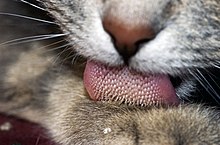
The hooked
papillae on a cat's tongue act like a
hairbrush to help clean and detangle fur.
A
tabby housecat uses its brush-like tongue to groom itself, licking its fur to straighten it.
Cats are known for spending considerable amounts of time licking their coats to keep them clean.
[107] The cat's
tongue has backwards-facing spines about 500
μm long, which are called
papillae. These contain
keratin which makes them rigid
[108] so the papillae act like a hairbrush. Some cats, particularly longhaired cats, occasionally regurgitate
hairballs of fur that have collected in their stomachs from grooming. These clumps of fur are usually sausage-shaped and about 2–3 cm (0.8–1.2 in) long. Hairballs can be prevented with remedies that ease elimination of the hair through the
gut, as well as regular grooming of the coat with a comb or stiff brush.
[107]
Fighting
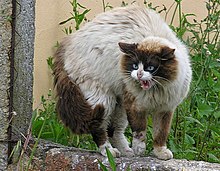
A domestic cat's arched back, raised fur and an open-mouthed hiss are signs of aggression
Among domestic cats, males are more likely to fight than females.
[109] Among feral cats, the most common reason for
cat fighting is competition between two males to mate with a female. In such cases, most fights are won by the heavier male.
[110] Another common reason for fighting in domestic cats is the difficulty of establishing territories within a small home.
[109] Female cats also fight over territory or to defend their kittens. Neutering will decrease or eliminate this behavior in many cases, suggesting that the behavior is linked to
sex hormones.
[111]
When cats become aggressive, they try to make themselves appear larger and more threatening by raising their fur, arching their backs, turning sideways and hissing or spitting.
[112] Often, the ears are pointed down and back to avoid damage to the inner ear and potentially listen for any changes behind them while focused forward. They may also vocalize loudly and bare their teeth in an effort to further intimidate their opponent. Fights usually consist of grappling and delivering powerful slaps to the face and body with the forepaws as well as bites. Cats also throw themselves to the ground in a defensive posture to rake their opponent's belly with their powerful hind legs.
[113]
Serious damage is rare, as the fights are usually short in duration, with the loser running away with little more than a few scratches to the face and ears. However, fights for mating rights are typically more severe and injuries may include deep puncture wounds and lacerations. Normally, serious injuries from fighting are limited to infections of scratches and bites, though these can occasionally kill cats if untreated. In addition, bites are probably the main route of transmission of
feline immunodeficiency virus.
[114] Sexually active males are usually involved in many fights during their lives, and often have decidedly battered faces with obvious scars and cuts to their ears and nose.
[115]
Hunting and feeding

A cat playing with a mouse. Cats play with their prey to weaken or exhaust it before killing it.

A domestic cat with its prey
The shape and structure of cats' cheeks is insufficient to suck. They lap with the tongue to draw liquid upwards into their mouths. Lapping at a rate of four times a second, the cat touches the smooth tip of its tongue to the surface of the water, and quickly retracts it like a corkscrew, drawing water upwards.
[116][117]
Free-fed feral cats and house cats consume several small meals in a day. The frequency and size of meals varies between individuals. They select food based on its temperature, smell and texture; they dislike chilled foods and respond most strongly to moist foods rich in amino acids, which are similar to meat. Cats reject novel flavors (a response termed
neophobia) and learn quickly to
avoid foods that have tasted unpleasant in the past.
[97][118] They also avoid sweet food and milk. Most adult cats are
lactose intolerant; the sugar in milk are not easily digested and may cause soft stools or
diarrhea.
[119] Some also develop odd eating habits and like to eat or chew on things like wool, plastic, cables, paper, string, aluminum foil, or even coal. This condition,
pica, can threaten their health, depending on the amount and toxicity of the items eaten.
[120]
Cats hunt small prey, primarily birds and rodents.
[121] and are often used as a form of pest control.
[122][123] Cats use two hunting strategies, either stalking prey actively, or
waiting in ambush until an animal comes close enough to be captured.
[124] The strategy used depends on the prey species in the area, with cats waiting in ambush outside burrows, but tending to actively stalk birds.
[125]:153 Domestic cats are a major
predator of wildlife in the United States, killing an estimated 1.4 to 3.7 billion birds and 6.9 to 20.7 billion mammals annually.
[126] Certain species appear more susceptible than others; for example, 30% of house sparrow mortality is linked to the domestic cat.
[127] In the recovery of ringed robins (
Erithacus rubecula) and dunnocks (
Prunella modularis), 31% of deaths were a result of cat predation.
[128] In parts of North America, the presence of larger carnivores such as
coyotes which prey on cats and other small predators reduces the effect of predation by cats and other small predators such as
opossums and
raccoons on bird numbers and variety.
[129]
Perhaps the best known element of cats' hunting behavior, which is commonly misunderstood and often appals cat owners because it looks like torture, is that cats often appear to "play" with prey by releasing it after capture. This
cat and mouse behavior is due to an instinctive imperative to ensure that the prey is weak enough to be killed without endangering the cat.
[130] Another poorly understood element of cat hunting behavior is the presentation of prey to human guardians. One explanation is that cats adopt humans into their social group and share excess kill with others in the group according to the
dominance hierarchy, in which humans are reacted to as if they are at, or near, the top.
[131] Another explanation is that they attempt to teach their guardians to hunt or to help their human as if feeding "an elderly cat, or an inept kitten".
[132] This hypothesis is inconsistent with the fact that male cats also bring home prey, despite males having negligible involvement in raising kittens.
[125]:153
Impact on birds

A black cat eating a house sparrow
On islands, birds can contribute as much as 60% of a cat's diet.
[133] In nearly all cases, however, the cat cannot be identified as the sole cause for reducing the numbers of island birds, and in some instances, eradication of cats has caused a "mesopredator release" effect;
[134] where the suppression of top carnivores creates an abundance of smaller predators that cause a severe decline in their shared prey. Domestic cats are, however, known to be a contributing factor to the decline of many species, a factor that has ultimately led, in some cases, to extinction.
The South Island piopio,
Chatham rail,
[128] and the
New Zealand merganser[135] are a few from a long list, with the most extreme case being the flightless
Lyall's wren, which was driven to extinction only a few years after its discovery.
[136][137]
Play
Play fight between kittens, age 14 weeks
Domestic cats, especially young kittens, are known for their love of play. This behavior mimics hunting and is important in helping kittens learn to
stalk, capture, and kill prey.
[138] Cats also engage in play fighting, with each other and with humans. This behavior may be a way for cats to practice the skills needed for real combat, and might also reduce any fear they associate with launching attacks on other animals.
[139]
Cats also tend to play with toys more when they are hungry.
[140] Owing to the close similarity between play and hunting, cats prefer to play with objects that resemble prey, such as small furry toys that move rapidly, but rapidly lose interest. They become
habituated to a toy they have played with before.
[141] String is often used as a toy, but if it is eaten, it can become caught at the base of the cat's tongue and then move into the
intestines, a medical emergency which can cause serious illness, even death.
[142] Owing to the risks posed by cats eating string, it is sometimes replaced with a
laser pointer's dot, which cats may chase.
[143]
Reproduction
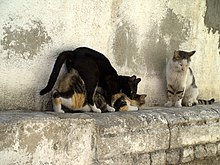
When cats mate, the tomcat (male) bites the scruff of the female's neck as she assumes a position conducive to
mating known as
lordosis behavior.

Radiography of a pregnant cat. The skeletons of two fetuses are visible on the left and right of the uterus.
Female cats called queens are
polyestrous with several
estrus cycles during a year, lasting usually 21 days. They are usually ready to mate between early February and August.
[144]
Several males called tomcat are attracted to a female in heat. They fight over her, and the victor wins the right to mate. At first, the female rejects the male, but eventually the female allows the male to mate. The female utters a loud yowl as the male pulls out of her because a male cat's
penis has a band of about 120–150 backwards-pointing
penile spines, which are about 1 mm (0.039 in) long; upon withdrawal of the penis, the spines rake the walls of the female's
vagina, which acts to
induce ovulation. This act also occurs to clear the vagina of other sperm in the context of a second (or more) mating, thus giving the later males a larger chance of conception.
[145] After mating, the female cleans her
vulva thoroughly. If a male attempts to mate with her at this point, the female attacks him. After about 20 to 30 minutes, once the female is finished grooming, the cycle will repeat.
[146] Because ovulation is not always triggered by a single mating, females may not be impregnated by the first male with which they mate.
[147] Furthermore, cats are
superfecund; that is, a female may mate with more than one male when she is in heat, with the result that different kittens in a litter may have different fathers.
[146]
The
morula forms 124 hours after conception. At 148 hours, early
blastocysts form. At 10–12 days, implantation occurs.
[148] The
gestation of queens lasts between 64 and 67 days, with an average of 65 days.
[144][149] Data on reproductive capacity of more than 2,300 free-ranging queens were collected during a study between May 1998 and October 2000. They had one to six kittens per
litter, with an average of three kittens. They produced a mean of 1.4 litters per year, but a maximum of three litters in a year. Of 169 kittens, 127 died before they were six months old due to a trauma caused in most cases by dog attacks and road accidents.
[9] The first litter is usually smaller than subsequent litters. Kittens are weaned between six and seven weeks of age. Queens normally reach sexual maturity at 5–10 months, and males at 5–7 months. This varies depending on breed.
[146] Kittens reach
puberty at the age of 9–10 months.
[144]
Cats are ready to go to new homes at about 12 weeks of age, when they are ready to leave their mother.
[150] They can be surgically
sterilized (spayed or
castrated) as early as seven weeks to limit unwanted reproduction.
[151] This surgery also prevents undesirable sex-related behavior, such as aggression,
territory marking (spraying urine) in males and yowling (calling) in females. Traditionally, this surgery was performed at around six to nine months of age, but it is increasingly being performed before
puberty, at about three to six months.
[152] In the US, about 80% of household cats are neutered.
[153]
